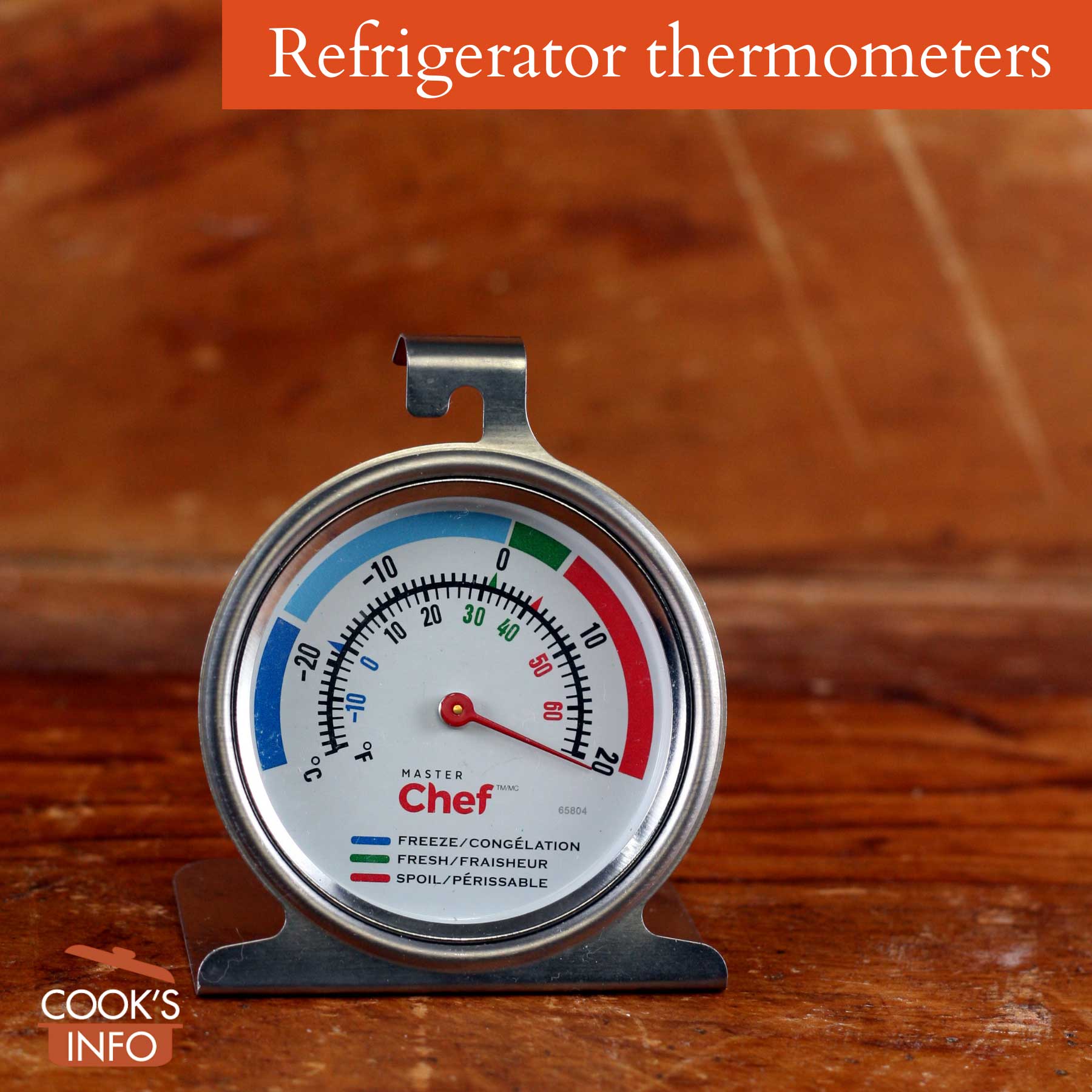
Refrigerator thermometer. © CooksInfo / 2020
Refrigerator thermometers are used to measure the running temperature of refrigerators and freezers in order to ensure that they are operating in a safe range to prevent food spoilage.
They will measure temperature ranges between a low of -40°C and a high of 15°C (-40°F and 60°F). They can be used both for the freezer and the fridge. They need to be relatively shatterproof, as they are bound to get knocked about inside the fridge over time. They should be rustproof as well, as they are bound to pick up some moisture or condensation.
Refrigerators should be 4°C (40°F) or colder. Most people just assume that any setting on their refrigerator dial that they pick is safe, and just rely on that to set the temperature. A lot of times, the dials are just numbers from 1 to 10, or even worse, letters such as from A to J, and when the fridge manual goes walkabout, as it’s bound to do overtime, you really don’t have any idea how cold you’ve got it set. You kind of just play it by ear. Oops, that setting froze the yoghurt and the kids’ lunches.
Freezers need to be below -18°C (0°F).
A refrigerator thermometer is useful when power blackouts occur. If you have one in your fridge, when the power goes back on, you can look inside the fridge and check the temperature. If the temperature is at 4°C (40°F) or colder, then you can know that your food will be fine. During a power outage, don’t allow anyone to open your fridge or freezer any more than absolutely necessary.
If you don’t have a fridge thermometer, but do have an instant read meat thermometer, you can still test your refrigerator temperature. Put a small glass of water in the fridge. There should be a good 10 cm or so (3 or 4 inches) of water in the glass. Let it sit there all day or overnight, then put the skewer part of the instant read thermometer in and let it sit there for 30 seconds or so. Ideally, put the glass of water in the centre of the middle shelf (and warn everyone that it’s there, so it doesn’t get knocked over in the meantime.) Or, if you have drinking water that has been chilling overnight in the fridge, you can measure it right away using that water.
Place your refrigerator thermometer in the centre of the middle shelf. Don’t put it on the door. Not only is it more likely to come flying off there, but the temperature varies too greatly on the door.
Many refrigerators now come with built-in temperature displays for both fridge and freezer. With some, lights will flash and an alarm will sound if the temperatures go above proper levels.
Cooking Tips
Items in the refrigerator need air space between them to stay cold, because the cold air has to circulate.
The usual figure bandied about is that if you hold the fridge door open for 10 seconds, it can take a fridge 40 minutes before the temperature recovers.
The debate still rages over whether to put hot stuff right in the fridge, or whether to cool it first. From one point of view, it’s best to get all items, no matter what their temperature, into the refrigerator right away. From the refrigerator’s point of view, if the fridge is suddenly packed with a lot of hot stuff, it can raise the temperature potentially endangering everything already in the fridge. Some say that a middle-ground is to pour a sink of water, add ice cubes to make an ice bath, and then set the pot or container in that to rapidly chill it, and then refrigerate it, but that sounds like an awful lot of fuss.
A large quantity of something will chill faster if you divide it up into smaller portions. One thing’s for sure, if the item you’re thinking of putting in the fridge is a relatively warm pot and you’ve got plastic shelves in the refrigerator, that would certainly be one item that isn’t going in the fridge on those shelves right away.

